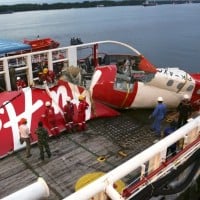Top 10 Plane Crashes that Most Shocked the World
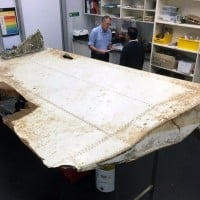
On March 8, 2014. A Boeing 777 carrying 227 passengers and 12 crew took off from Kuala International Airport in Malaysia, heading for Beijing in China. Shortly after takeoff, contact with ATC was lost, but remained on military radar. That was short-lived as well, as the plane disappeared from military radar.
More mysteriously, shortly after the disappearance, communications were sent from where the plane was last tracked. This lasted until 9:15 in the morning at MYT Time. The last communication was near Australia in the southern indian ocean. Then, nothing.
Before they learned about the commucations, search and rescue was sent to the last location that Flight 370 was tracked on ATC radar, and they found nothing. And then they started searching in the Indian Ocean, this had continued for nearly three years until the search was called off in 2017.
However, after a year of nothing found, On July 29, 2015, several pieces of marine debris was found on the beach of Reunion Island. The malaysian government confirmed this to be off the aircraft.
The cause of the disappearance is unknown, as the wreckage was never found. The believeable causes for the crash is pilot suicide, hypoxia, cyberattack, etc.
Shortly after Flight 370 disappeared, things were about to get more uglier. On July 17, 2014, a Boeing 777 carrying 283 passengers and 15 crew, disappeared from radar over Ukraine. Unlike Flight 370, they did manage to find the plane, but destroyed and in ruins. Bodies were scattered and the site looked like a warzone.
After a year of investigation, the final report was released and concluded that the accident was a accidental shoot-down by pro-russian insurgents.
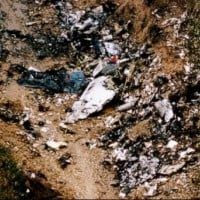
On September 8, 1994, A Boeing 737-300 was traveling from Chicago to Palm Beach with a stopover to Pittsburgh with 127 passengers and 5 crew members.
Flight 427 was approaching Pittsburgh at 6 thousand feet when the plane had encountered wake turbulence from a Boeing 727 operated by Delta Air Lines. Suddenly, the plane banked to the left, entered an aerodynamic stall and crashed nose-first into the ground.
It took the NTSB four and a half years to investigate the accident. The NTSB had concluded the rudder (Which controls the direction of the aircraft) had malfunctioned and went hard-over in a direction opposite to that commanded by the pilots.
3 years earlier, a Boeing 737-200 operated by United Airlines with 20 passengers and 5 crew had suffered the same fate but instead banking to the right and crashing into a park. The original investigation was unable to come up with the cause, but after the final report of USAir flight 427, the case was renewed and in 2001, the final report of the accident concluded that it also had a rudder hardover.
It isn't the end of the story though. Nearly 2 years later after Flight 427, A Eastwind Airlines Boeing 737, had also had a rudder hardover in mid-flight, but were able to land their aircraft. Only the flight attendant was injured.
After the three accidents, Boeing had reportedly spent $500 Million on upgrading on all their thousands of Boeing 737s.
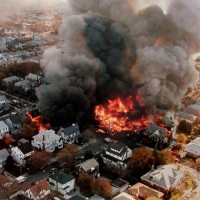
On November 12, 2001, Airbus A300 operated by American Airlines with 251 passengers took off from JFK International Airport. While climbing, the plane had encountered wake turbulence from a Boeing 747 operated by Japan Airlines. Suddenly, the plane pitched downwards and was plummeting into a neighborhood in Queens, New York. The engines broke off from the wings and crashed into the neighborhood, killing all 260 on board along with five people on the ground.
Since this took place in New York and 2 months after the September 11 attacks, fear spawned that the attack was repeated and buildings around New York was evacuated. Worse, terrorists had confirmed it was a terrorist attack. The FBI was even involved in the investigation. But after the vertical fin was founded miles away in a river, the terrorism theory was written off.
The probable cause for the accident was when the plane encountered wake turbulence, the co-pilot had putten the rudder to stress due to his unnecessary inputs, causing the vertical fin to snap off and the plane into a dive.
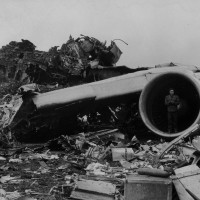
March 27, 1977 was the day that would scar and haunt aviation permanently.
At Los Rodeos Airport (Now called Tenerife-North Airport). A Boeing 747 operated by Pan Am carrying 380 passengers and 16 crew was on a runway and was about to turn onto a taxiway when the pilots noticed a KLM Boeing 747 carrying 234 passengers and 14 crew, was heading for them. The KLM crew noticed this as well and attempted to take off, but suffered a tailstrike, it did get airborne, but it was too late. The KLM aircraft collided with the Pan Am, stalled and hit the ground 500 ft away from the collision point. Since the KLM aircraft was full of fuel, the plane ignited and killed all 248 passengers and crew.
Despite killing 335 passengers and crew on the Pan Am, 61 passengers and crew that were seated at the front section, survived (Including the captain, first officer and flight engineer). However, 583 people where killed in the accident.
The cause for the accident was the KLM Captain's decision to take off in the mistaken belief that the ATC had cleared him for take-off. Another contributing factor was the low visibility as the airport was filled with fog. The disaster remains the worst disaster in aviation history
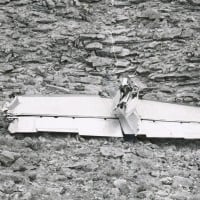
On June 30, 1956. It was a normal day for Air Traffic Controllers until they lost contact with both United Airlines Flight 718, A Douglas DC-7 aircraft heading for Chicago Midway Aircraft with 53 passengers and 5 crew members and Trans World Airways Flight 2, a Lockheed L-1049 Super Constellation heading for Kansas City Downtown Airport with 64 passengers and 6 crew members over the Grand Canyon. They had no idea on what happened to both aircraft when a search team found both planes, wrecked and destroyed.
After investigating, it was concluded that both planes had collided at 21,000 feet due to that both planes could not see each other due to the design of the cockpit windows. However, there was also no way that the ATC could know about the collision due to the system was inadequate and there was no technogly back then.
The DC-7 had clipped the Constellation's vertical stabilizer and stuck the fuselage, causing the TWA plane's empennage to break up, enter a dive and crashed into the ground, killing all 70 on board. The DC-7 had remained in air but was descending rapidly and was impossible to recover. The plane then slammed into a cliff, killing all 58 on board.
The accident had caused the formation of the FAA and the ATC system was upgraded across the USA, costing $250 million.
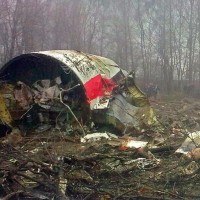
On April 10, 2010, a Tu-154, operated by the Polish Air Force, was carrying the president of poland Lech Kaczynski and 88 other important figures of Poland when it failed to arrive during approach in Smolensk, Russia. After a search and rescue mission was launched, all they found was debris and human remains. None of the 96 people on board survived.
Fear had spread that the crash was a political assassination, as the plane was carrying politicians of Poland and relatives of victims that perished in Katyn massacre. However, what actually happened was a accidental crash. During approach, the pilots had failed to conduct the approach in a safer way in low visibility. Which the plane ended up clipping a tree and crashed upside down, killing all 96 people on board.

On October 31, 1999. A Boeing 767, carrying 203 passengers and 14 crew members, took off from John F Kennedy Airport and was heading for Cairo International Airport in Egypt. Shortly after takeoff, the plane suddenly vanished from radar, and after a while of trying to communicate, the ATC had asked other planes nearby to head for the loaction of where Flight 990 was last tracked, they reported nothing unusual.
At sunrise, search and rescue ships found debris and body parts floating. None of the 217 people on board survived.
After a two-year investigation, the final report by NTSB was released. They conducted that the crash was due to the co-pilot relief's deliberate actions of putting the plane in a dive while the captain was outside the cockpit. The captain managed to get back in the cockpit. The only words that the co-pilot had said was "I rely on god". However, the Egyptian government had disputed the report and had it's own investigators do the job. They had concluded themselves that the crash was due to a mechanical failure of the elevator's control system.
Since then, the crash had strained relations between the United States and Egypt.
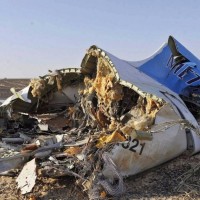
On 31 October, 2015. A Airbus A321 operated by Metrojet carrying 217 passengers and 7 crew members, took off from Sharm El Sheikh International Airport. Suddenly, the plane disappeared from radar at 6:13 EST. When Egyptian authorities, all they found was the destroyed aircraft. The tail was found 5 kilometres away from the main crash-site, indicating that the plane had broken up mid-flight.
Shortly after, terrorist group ISIL claimed responsibility, claiming the aircraft was bombed. At first, investigators disagreed, as information arrived that the plane had suffered a tailstrike on landing on 16 November, 2001. However, more news from ISIL had circulated, claiming that a Schweppes can filled with TNT had caused the plane to break up. After investigating this, it was confirmed that ISIL had in fact, bombed an airliner heading for Russia.
As of 2017, the final report has yet to be released.
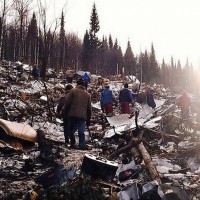
Despite only killing 75, this accident is on here due to a very unusual factor to this crash.
On 23 March, 1994, A Airbus A310 carrying 63 passengers and 12 crew members, crashed 20 kilometres off Mezhdurechensk, Russia. The crash was a blow for Aeroflot, as they had added in aircraft from other countries in order to decrease the chance of a another crash. (Aeroflot had had a very poor safety record for many decades, killing 8 thousand passengers and crew)
The investigation into this accident had came across a chilling and very unusual factor to this crash, the captain had allowed their children to sit in his seat. His daughter had refused to sit in the seat any longer, allowing the 15 year old son to sit. He unknowingly disengaged the autopilot, causing the plane into a steep-bank. Problems were about to get worse. The plane had recovered, but the first-officer had over-corrected the problem by pulling up all the way, causing it to stall. The plane nearly recovered again, but crashed into a field, killing all 75 people on board.
(Personal fun-fact to add in. My parents were in russia at the time when the accident had occurred and when hearing about the crash, they refused to fly with Aeroflot and ended up staying there for 10 months before turning safely to Germany in late 1995)
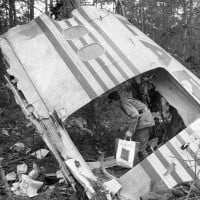
On March 3, 1974. A DC-10 operated by Turkish Airlines carrying 334 passengers and 12 crew, suddenly went down in a forest at Oise, France. The plane suffered a explosive decompression and crashed, killing all 346 passengers and crew. At the point, the crash was the worst in aviation history. The wreckage was so fragmented that it was difficult to determine whether any parts of the aircraft were missing before it crashed. Only nine bodies were never identified.
The investigation concluded that the plane's cargo door was improperly secured and ended up breaking off, causing the explosive decompression and also damaging most of the control systems, rendering the plane uncontrollable and impossible to recover from.
Another thing to mention. Back in 1972, An American Airlines DC-10's cargo door also broke off, but managed to safely land in Detroit, saving the lives of all 67 people on board, but 11 people were injured.
